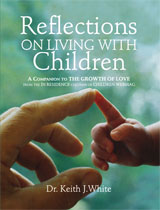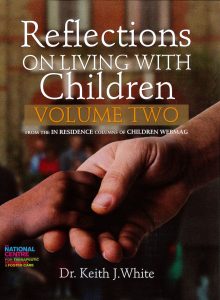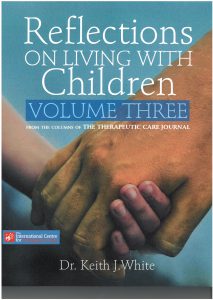


Reflections on Living with Children
These three collections of articles, were written for the Children Webmag and subsequently The Therapeutic Care journal over a period starting in 2001. The experiences and reflections that they describe have formed the raw material for the book The Growth of Love. The articles are arranged using the five main themes of that book. The columns were intended to be accessible to all who are involved with children, whether as parents, carers, teachers or pastors. For students preparing for work in social work or child care the book will provide welcome fresh descriptions of life with children, as well as a wealth of ideas and comments. There is an extensive index and many reference works are quoted.
Cost: £10.99 each, including postage and packing
Reviews
Keith White’s recent book, Reflections on Living with Children: A Companion to the Growth of Love paints a picture of the ground that nurtured his earlier book, The Growth of Love: Understanding Five Essential Elements of Child Development
Taken together, the two books set out what Keith has learned about what matters in living with children. They are full of stories of children and adults, of the events that shape their lives, and lead to an analysis of how to create the space in which children may be held and healed. The Growth of Love was reviewed in the Children Webmag (June 1, 2008) but I shall refer to it in this article as I attempt to convey my thoughts on his more recent book.
The books are inspirational; they are challenging of conventional wisdom and practice; they offer hope. I recommend them unreservedly. There are two key dimensions: the first is the setting out of his growing understanding of what is important in living and working with children; secondly there are lovely, often moving, accounts of what children say or of episodes in their lives.
The fundamental thrust is of what you have to provide for children, for all children not just those who need a therapeutic environment. The core of such provision, Keith argues, is: security; boundaries; significance; community; and creativity. It is from these that love can grow. What we call residential care, as other activities such as education, must build on the foundation of the personal involvement of the adult with the child in which the adult travels on a journey alongside the child.
Much of Reflections is mundane in the sense that it is of the world, the nitty-gritty of daily life. In some ways reading Reflections after The Growth of Love is like watching a prequel to a film: you discover what had gone on before the start of the film you are watching. Reflections is an edited collection of Keith’s In Residence contributions to the Children Webmag. Most of the articles are of the type where the author tries to convey the essence of Mill Grove, the place where he lives and works, though he tends to downplay the work aspect of his time at Mill Grove. Often triggered by a particular episode, a holiday in North Wales perhaps, or a member of the wider family returning to Mill Grove, he draws out for the reader (sometimes discovering a truth for himself in the process) the underlying, essential characteristic of being available to others.
It is fair to point out that a book that contains so many articles of one or two pages is not always easy to read. That is to say that although each of the articles is in fact beautifully written, trying to read them one after another as I have done for this review is not easy. Because each article is complete in itself, immediately rushing into another one is rather like working your way through a book of short stories without pausing to absorb the feeling and sense of each one.
There are other important background points. The first is that neither volume is a textbook. They are not designed as manuals. Deliberately, they do not tell you what to do. Indeed, rightly, they take a strong stance against a mechanistic approach to living and working with children. What they offer is profound thinking about the way that we live with others, in particular with children, and the way that we ought to live.
Following on from this the message is clear, and one that is vital for getting in touch with children: there is no prescribed way to create a safe space for children; the adult has to be available and to respond to the child’s pace. So these books do not tell you what to do when a child will not get out of bed in the morning or will not talk to you.
Secondly, the books draw heavily on Christianity and child theology. This is proper as it is the bedrock of Keith White’s life. It is familiar to me, growing up as the son of a Methodist minister. But I do think the juxtaposition of day-to-day life with biblical critique makes for difficulties for readers who not only may not share his faith but may find the language or the framework difficult to understand. The temptation, I suspect, would be to ignore the specifically theological discussions. I think this would be a loss as it is his searching at theology that leads to his understanding of living with children.
There is no difficulty for a non-Christian reader in looking at and recognising his key themes such as security and boundaries. The difficulty emerges when examining what makes sense of life, what allows people to realise a purpose in living. Keith himself asks how the imparting of values is handled by those of no particular faith. Elsewhere there are specific questions for churches or Christians, for example, whether Christian organizations tell children the stories of Jesus. I think it would be helpful to consider the way that a non-Christian could work at the theology. That may be a task for someone other than Keith.
There is one other response to reading these books that I want to acknowledge. I have no way of knowing whether this will resonate with other readers. This sort of writing about one’s work, one’s life and one’s beliefs pose challenges to the reader. I do not doubt the enduring worth of Mill Grove nor of Keith White’s enduring commitment to those with whom he lives. And I sense from the way that he writes of a groundedness in his own life. Inevitably, at least I think inevitably, this leads me to look at my own life and question. There is a touch of envy. In some ways Keith could be seen as a biblical prophet, reminding those who will hear of the core of their beliefs and asking questions as to the direction in which they are travelling. Listening to prophets is not always comfortable, nor should it be.
Having tried to put the books in some sort of context I want to return to the reasons that I think they are so important. In doing so I shall permit myself the indulgence of my own reminiscing on North Wales, the place where the Mill Grove family spend their holidays every year. I had not expected when reading these books to be taken back to Black Rock sands and Criccieth. In my adolescence as a family we spent many holidays around Beddgelert; my parents had a house built just above the Glaslyn for their retirement and I returned there camping with my own children and then with boys from the approved school where I worked; indeed, I remember bumping into David Lane, the Editor of the Webmag, when as schoolchildren we were both separately holidaying near the Glaslyn. Just last summer I returned there and climbed Tryfan and the Snowdon horseshoe with my three adult sons. I know that the place is important to me because of the opportunities to discover and grow. We had similar experiences to the Mill Grove family of adventure, risk, survival and fun. We become who we are through such experiences. Going there always has the joy of return to a familiar place. The memories are so strong that I am tempted to try to capture my own adventures. But I must return to what I am meant to be doing, reviewing the books.
Keith White’s writing is important because it allows, indeed demands, consideration of what is the essence of residential practice. The serious reader does not have to come up with Keith’s answers but should use the material to challenge self and others.
I remember debates in the 1960s and 1970s as to the nature of residential childcare:
- an art or a science?
- an innate quality or something learnt through training?
- a branch of social work or childcare?
And so we might go on. I recall too the debates in the same era as to how to professionalise residential work with children. At that time I was lecturing in residential social work at Bristol University and working with some staff from local children’s homes. This was a time when many local authority children’s homes were run by a matron who lived with her family in the house alongside the ‘cared for children’ while her husband went out to work. Clearly I remember visiting one such home and being impressed with the quality of life and the sharing of space between children and adults. But such sharing was deemed ‘non-professional’, frowned on and then banned: staff had to live out so that they could recharge their batteries, they were told, and establish a proper distance from their work.
Another memory is of working at understanding, writing and talking about the theoretical base of residential child care. “Love”, as Bettelheim argued, “is not enough”. Living with children was more than acting on instinct; it had to be thought about. Yet too often I have seen such theory misunderstood, distorted and turned into a formula. A prime example is what we have learnt about the process of bereavement: thus we know that many people go through stages of denial and anger before coming to some sort of acceptance or resolution. But that does not mean, as I have seen some professionals interpret the ideas, that all people must be ‘helped’ or forced to go through such stages.
One last example must suffice. The understanding of the importance of continuity of adults for children led to the creation of a role called a ‘key worker’. But the creation of such a post does not solve the dilemma of how people can be workers and reliably available. There is no mechanistic solution to the dilemma. It has to be planned for and worked at.
Numerous other questions or dilemmas emerge for me. I suspect each reader will find their own. Some of mine are: –
- What have been the losses as homes have become ever smaller? Keith suggests that the right size is found when a child feels safe and is able to play and expand.
- Is it time to press the large Christian based voluntary child care organisations to dip their toes back in the water of residential child care? Might not their founders think that there has been a loss that they have not been prepared to take a lead in showing how children can live in places where there are professional staff who are committed to children, and where children are known personally after they have left? Such commitment, Keith contends, has to be from an individual. My own take on this is that children have to be held in mind, to be thought about and worried over when not in front of you.
- Are there other types of organisations that can replicate such commitment? This is no certainty that this is provided in foster care.
- What are the implications for life in children’s residential child care establishments of being true to the creative tensions inherent in childhood?
There are other threads in the books that I want to highlight.
1. Recognising that children can be partners in the creation of the secure base: staff receive from children as active agents rather than simply teach and educate.
2. The necessity to challenge ‘the short termism of much family intervention’.
3. Boundaries are created by the predictability of patterns of life as well as rules.
4. The importance of learning the life stories of the children, which is not the same as requiring the creation of life story books.
5. The need to create space for children to thrive without adults necessarily doing things for them.
6. In a therapeutic environment you never know when or what will trigger insight.
In the second half of Reflections the style of articles is different. Rather than using an event to trigger reflection on living with children, Keith White writes about policy and practice.
- Do children need much greater protection from TV and the internet?
- What’s the point of children’s reviews?
- Is there a difference between being child-centred and child-focused?
- What’s going on in the care system?
These pursue in greater depth the same type of challenging ideas as referred to earlier.
The value of the books is that they search for an understanding of what is central in living in residence with children. Many children have found this neither in their family nor in residential homes. Thus the answer to the earlier questions as to the nature of the activity of residential work with children is that the fundamental must be that what we call residential care, treatment or work is a way of life. Mill Grove may be an inspiration and resource for other establishments but the very nature of the place means that it will never be a model for others. The challenge is how to embed the central characteristics identified in these studies in the very different organisations that provide, commission and inspect the places where children live.
Residential life, Keith says, is like a compost heap: you put the relevant materials on the heap and leave the rest to happen; it may be messy.
White, Keith (2008) The Growth of Love: Understanding Five Essential Elements of Child Development
, Abingdon: The Bible Reading Fellowship
ISBN 978-1-84101-461-6
White, Keith (2010) Reflections on Living with Children: A Companion to the Growth of Love.
, London: WTL Publications
ISBN 978-0-9564757-0-1
Roger Clough is Professor Emeritus of Social Care, Lancaster University
